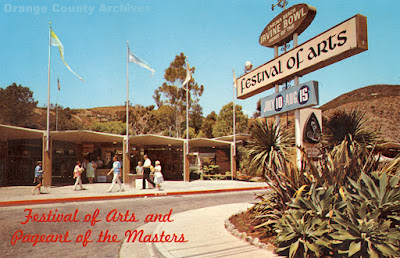The Irvine Bowl and the adjoining festival grounds weren’t the original home of The Festival of Arts and Pageant of the Masters, but they have served that purpose for generations and are now an important part of the history of Laguna Beach.
Laguna Beach artist John H. Hinchman launched the Festival of Arts in 1932, based in part on South Coast News editor Sumner Crosby’s concept for an “intellectual carnival.”
The hope was to draw tourists already visiting Southern California for the Olympics and support local artists. The first Festival was held on El Paseo Street and for some years the event floated from one available location to another. “Living pictures” made their debut in 1933 as the “Spirit of the Masters Pageant.” The Festival of Arts Association was formed in Sept. 1934 and the first official Pageant of the Masters was presented in 1935. Over time, the event grew in size and popularity and proved itself an excellent way to bring people, money, and positive attention to the little town of Laguna Beach during the cash-strapped years of the Great Depression.
In February of 1940, the Laguna Beach City Council first considered the purchase of land for a new “Laguna Canyon Park” near the mouth of Laguna Canyon. A natural bowl had already been identified as an ideal spot for an amphitheater within the park. In April, the citizens of Laguna Beach voted for a 10-cent tax levy (for each $100 of taxable property) to fund the project. That summer, attendance at the Festival of the Arts broke records, with standing room only at the Pageant of the Masters. Among the attendees was Mrs. James Irvine.
The City Council was presented with an initial proposed outline of the new park project in March 1941. The plan required the purchase of land from both James Irvine, owner of the vast Irvine Ranch; and Walter E. Pyne, who’d made his fortune in the player piano business before striking it even richer when oil was discovered under this Santa Ana Canyon orange groves.
Laguna’s initial park plans included restrooms, a road to the bowl area, and the grading and paving of the amphitheater. The Festival Association offered to donate $3,000 toward the project as well as to build the stage and dressing rooms and to provide lighting and insurance.
In May, the city reached an agreement with Irvine regarding the eighteen acres that were to be acquired from him. Irvine made numerous concessions in order to aid the Festival, including allowing them to use this acreage for years prior to the actual transfer of ownership.
May 1941 also saw the city purchase land from Pyne and finalize plans for construction. Grading of the amphitheater began almost immediately thereafter.
On July 30, 1941, the Festival of the Arts opened with the dedication of the new Irvine Bowl. The Santa Ana Register reported: "Among the special guests to be introduced are Mr. and Mrs. James Irvine, in whose honor the bowl is named. It was through the cooperation of Irvine that the recreation park project was realized." The Bowl, however was not quite ready to be used yet. In fact, it would not be used for its intended purpose until 1946, when the Festival and Pageant returned after a wartime hiatus that lasted from 1942 through 1945.
The Irvine Co. donated the land to the City of Laguna Beach on Dec. 29, 1947, with the conditions that, 1) The City use the property "for the following purposes only, and for no others, to-wit: For the construction, enlargement, improvement, maintenance and operation of the outdoor amphitheater now situated thereon and known as 'Irvine Bowl', for the production and holding of public concerts, theatrical performances, festivals, exhibits, and any and all forms of public entertainment and recreation"; and 2) That if the City ceased to use the property for these purposes or used them for other purposes, that the land would revert to the Irvine Co.
An improved stage for the 2,600 seat amphitheater was constructed in 1953, replacing the original which has been described as “barnlike.”
Aside from 2020, when they were closed due to COVID-19 fears, the Irvine Bowl and adjoining festival grounds have continued to be an important local hub for the arts in Southern California.




No comments:
Post a Comment